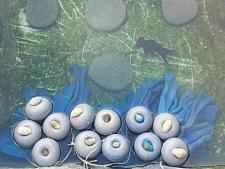| Back to Back Issues Page |
 |
|
The Goldfish Gazette, Issue #011 -- Setting Up a Spawning Pond November 30, 2014 |
Goldfish Care Tips and GuidelinesA Free Monthly Resource For Goldfish Enthusiasts In this issue Setting Up a Spawning Pond
A well set up spawning pond will maximize the number of fry from a spawning. Even relatively small fish can produce thousands of fry, more than enough for most enthusiasts. Most of these techniques were developed over time when I had my commercial operation. A spawning of a few hundred fry was more of a nuisance than a benefit as my raising ponds were set up for raising thousands of fry. The setup in the image above produced approximately 2000 Black Moor fry from one small 2 1/2" (body length) female and 3 males. Simple Rules When Setting Up a Spawning Pond
The last trick I use to maximize fry numbers is to cover one half of the bottom of the pond with clear plastic film. Goldfish are egg scatterers, and those eggs that miss sticking to the spawning media tend to get pushed away from the media by the parents' thrashing tails. A large number of eggs end up floating away from the media until they eventually settle on the bottom up to two feet away. If you intend using plastic film, check, check and triple check that the edges are held down securely with flat rocks or something similar, as I have had fish get under the plastic and suffocate. Don't be tempted to use the black plastic film as it causes extreme temperature increases as the sun strikes it. To read more on this subject and tips on how to breed goldfish successfully click here... What's New On The WebsiteBrine ShrimpI thought it an appropriate time to update the brine shrimp page showing my hatchery and what the hatched nauplii should look like prior to harvesting and feeding to your fry.
Comments? Ideas? Feedback? I'd love to hear from you. Just reply to this e-zine and tell me what you think, or what topics you want covered. Next Month’s Topic How to cull goldfish fry. |
| Back to Back Issues Page |